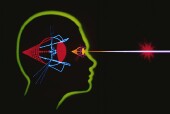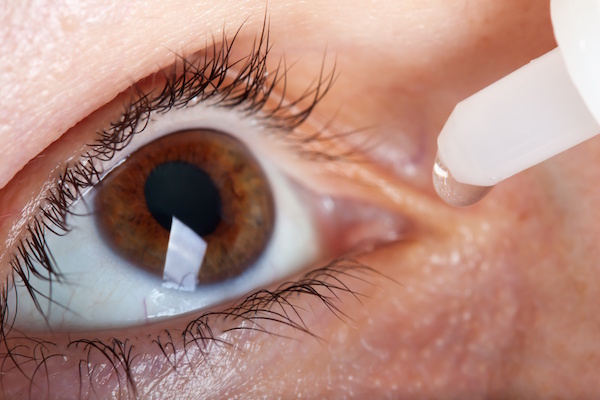
THURSDAY, Feb. 14 (HealthDay News) — An implanted, sight-enhancing device some are calling a “bionic eye” is the first to gain approval for use in the United States, officials announced Thursday.
According to the U.S. Food and Drug Administration, the new Argus II Retinal Prosthesis System can help patients with a genetic eye disease called retinitis pigmentosa regain some sense of vision. About 100,000 Americans are believed to be affected by the illness, which causes a gradual deterioration of the eyes’ photoreceptor cells.
The new device uses a tiny video camera attached to eyeglasses that transmits images to a sheet of electrode sensors that have been sewn into the patient’s eye. These sensors then transmit those signals to the brain via the optic nerve. The device helps replace the damaged cells of the retina and helps patients see images or detect movement.
“It’s a start, it’s a beginning,” said Dr. Mark Fromer, an ophthalmologist at Lenox Hill Hospital in New York City. “It’s going to be exciting for people who get this device who are currently just seeing light or dark, [they] will see shapes and that will be life-altering for them.”
An FDA official was similarly enthused.
“For many of the approximately 1,300 individuals who will develop the disease this year, this technology may change their lives,” Dr. William Maisel, deputy director for science and chief scientist at FDA’s Center for Devices and Radiological Health, said in an agency blog post. “It’s the difference between night and day,” he added.
Maisel’s post also included testimony from people who had tested the device and spoke in favor of its approval at a recent FDA hearing:
“The biggest thing to me was being able to see the crosswalk lines on the street so I can safely cross streets in Manhattan,” one user said.
“The most exciting day to me was October 27th, in 2009,” another testified. “It was the first time I was able to see letters on the monitor screen [during a test of visual perception]. I had not seen letters since 1994, so that was huge.”
A third person said he had a 17-year-old son, “and I don’t mind telling you how much — I mean, how happy that made me, not only to see the silhouette of my son, but to hear that voice coming and saying, ‘Yeah, it’s me, Dad. I’m here and I love you.'”
People with retinitis pigmentosa suffer damage to the light-sensitive cells of the retina. As these cells slowly degenerate, patients lose side vision and night vision and later on, central vision. The disease can cause blindness,
The FDA’s approval is a limited one, labeled a “humanitarian use device” approval, meaning the Argus II can be used only for fewer than 4,000 patients per year.
The FDA is currently restricting approval to people aged 25 years and older who have severe retinitis pigmentosa and can see light but not identify its source. Eligible patients also include those who cannot see light, but who have some retinal function and a history of being able to see forms.
In addition, patients must be willing and able to get the recommended follow-up, device fitting and visual rehabilitation, the agency said.
Dr. Robert Greenberg, president and CEO of Second Sight Medical Products Inc., the maker of the device, said that “patients with retinitis pigmentosa in the United States for the first time ever will [now] have a treatment option.”
Greenberg said the device does not restore full vision, but does give patients what he calls “low vision,” meaning it lets them perform visual tasks that they couldn’t otherwise do.
This is only the first step, Greenberg added. “One of the great things about the Argus II system is that it is a software-driven system,” he said, and “we expect to be producing software upgrades for all the implanted patients.”
Current lab work suggests those upgrades will include color vision and sharper images, he said. “We are also working on more advanced implants,” Greenberg said.
The device is not cheap — in Europe, where the device has been approved for use for several years, it typically costs about $100,000, with an additional $16,000 for the operation. The company hasn’t set a U.S. price yet, but Greenberg say it is going to exceed $100,000.
Insurance typically covers the cost in several European countries, and the company has started a process to get it covered in the United States, Greenberg said.
To gain FDA approval, the system had to go through a clinical trial to see if the device was both safe and effective. The results showed that most participants could perform basic activities better with the device than without.
Activities tested included locating and touching a square on a white field; detecting the direction of a motion; recognizing large letters, words or sentences; detecting street curbs; walking on a sidewalk without stepping off; and matching black, gray and white socks, according to the FDA.
Among the 30 people in the study, 19 had no adverse events related to the implant surgery.
Eleven patients, however, did experience serious problems. These included erosion of the layer covering the eyeball called the conjunctiva, opening of the wound left by the operation, retinal detachment, inflammation and low pressure in their eyeball, the agency noted.
More information
For more information on retinitis pigmentosa, visit the U.S. National Library of Medicine.

